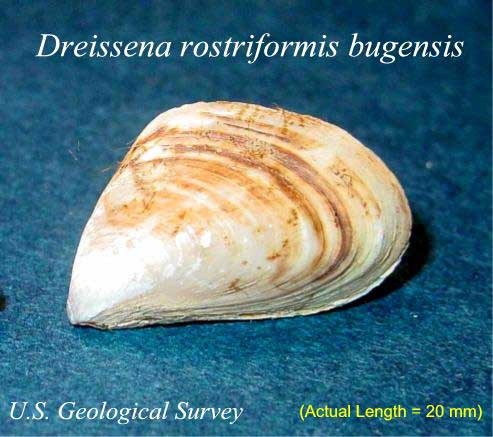Quagga Mussels on the Lower Colorado River
History and Background
Quagga mussels were discovered at Lake Mead on January 6, 2007. This was the first sighting of this mussel west of the Rocky Mountains, although it has been in North America since the late 1980ís. Scientists believe it may have arrived at Lake Mead as early as 2005, probably on a boat trailered from infested Midwestern or Eastern water bodies. These mussels can form massive colonies, potentially causing a shift in native species and disrupting the ecological balance of the water body. The colonies also can block water intakes, affecting municipal water supply, irrigation and power plant operations. Federal, state and local natural resources and water management agencies immediately conducted inspections of facilities along the lower Colorado River. Mussels were found in extremely low densities at external locations on Hoover, Davis and Parker Dams, but were not found in the water supply or other piping systems inside the dams. Mussels were also found at two fish hatcheries, at other marinas on Lakes Mead and Mohave, and at the major Arizona and California diversion points in Lake Havasu. Since January 2007, the mussels also have been found in canals and lakes in southern California, in Arizona, and in the river mainstem as far south as the Imperial Diversion Dam, 20 miles north of Yuma, Ariz. Significant resources have been expended by state, federal and local agencies on public outreach, monitoring, and some localized eradication programs to try to prevent their further spread. Since January 2007, Reclamation has undertaken numerous actions to address the discovery of quagga mussels in the lower Colorado River system. The Lower Colorado Region has conducted an extensive literature search to learn more about the musselsí potential impact on hydroelectric and other infrastructure; conducted research on mussel control/eradication methods; conducted a joint Lake Mead/Lake Mohave water sampling program with the National Park Service-Lake Mead National Recreation Area and Reclamationís Environmental Serviceís Division to determine mussel larvae densities; participated in technical meetings focusing on mussel prevention, control and/or eradication methods; participated in resource management agency outreach efforts designed to inform recreational boaters about how to prevent the spread of mussels between water bodies; formed an information-sharing partnership with other water providers in the lower basin whose facilities are or might also become infested; had a consulting firm experienced in mussel control conduct an in-depth assessment of Hoover, Davis and Parker Dam powerplants to determine the areas most at risk of colonization and preventative or control methods, and participated in outreach efforts in other regions to share information about possible control or preventative methods, new biological information, etc. with facilities that might also become infested. The potential for quaggas to affect operations at Reclamationís facilities on the lower Colorado River is greatest at Parker Dam, as Lake Havasu appears to provide the greatest opportunity for rapid mussel growth and colonization. Reclamation's Lower Colorado Dams Office has increased mussel detection strategies and preventative maintenance activities at this facility. Of primary concern is the domestic water line, which services the damís restrooms, air conditioners, and other equipment, but not the generators. The penstocks are not currently a concern, although the various bulkheads, trashracks and sample plates at the dam are heavily infested. The water line is being inspected more frequently, and a new type of filter will be installed and tested soon. Action plans are also in place for Davis and Hoover Dams.  |
Webmaster: sha-lcr-webcomments@usbr.gov
Updated: June 2008

